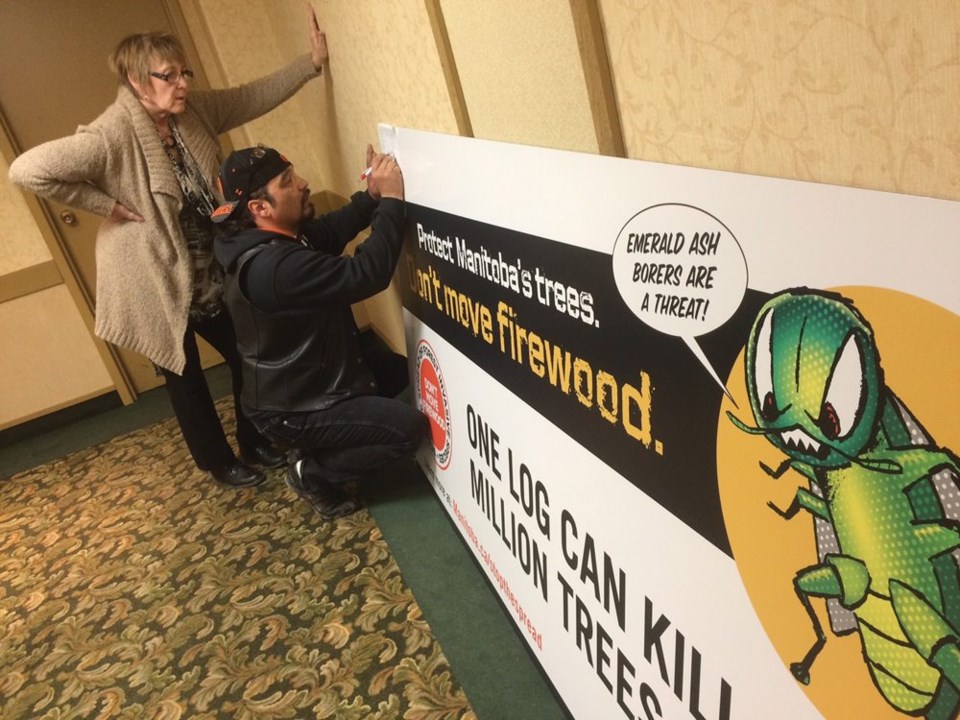Allan Derhak doesn’t want to think what his hometown would look like stripped of trees.
Neepawa is renowned for its beauty and in large part because its residential streets are lined with mature elm, cottonwood and green ash trees.
But Derhak, a public works employee in Neepawa, knows many of those trees’ days may be numbered — if emerald ash borer (EAB) hits.
Hard to detect at low population levels, EAB is an invasive insect that will kill green ash if it gets into this tree species. It made Manitoba headlines last December when the Canadian Food Inspection Agency detected it in Winnipeg. The bug has moved 700 km westward from its last known location 700 km away in Thunder Bay.
Steps are being taken to contain it but there is a high risk of its spread across more of Manitoba due to the high numbers of green ash trees in shelterbelts, natural areas and communities.
If and when it reaches Neepawa, they expect they will be clear-cutting stands of trees, Derhak said. He can already see what a mess — and expense — looms.
“It would be very tough to deal with,” he said. “The cost of that… it would be devastating.”
Derhak was among about 65 urban foresters and municipal officials from over 20 Manitoba communities meeting in Portage la Prairie this month to talk over not just how to deal with EAB, but ways in general to support tree-care programs in towns and villages across the province.
There’s intensifying need to get tree care placed higher on municipalities’ to-do lists, with the spectre of invasive diseases and pests posing significant threat to local tree populations, speakers said.
The problem right now is many places don’t recognize the value of their trees, and at the same time lack capacity to even begin to inventory and evaluate their trees’ social, economic and environmental benefits.
“We just generally don’t have enough resources and dollars to do all this,” said Martha Barwinsky, Winnipeg-based urban forester and the Prairies representative with the Canadian Urban Forest Network, who hosted the meeting.
There are notable exceptions in Manitoba, however.
In 2016, Morden completed a comprehensive boulevard tree inventory, collecting data on what types of trees were growing in the city, and what condition they were in.
That inventory has also quantified the ecosystem services the city’s trees are providing in terms of shade and energy reduction, carbon dioxide absorption, increased property values, storm water retention and air quality improvements, arriving at a value of over $7.4 million of services from the city’s 5,330 boulevard trees. (Trees on private properties and found in natural stands within the city are not included in the valuation.)
That inventory also provided the city council with a cost-benefit ratio for decision-making regarding investments in long-term tree care and maintenance; knowing it has more to gain from saving its trees than losing them, Morden has recently launched a 10-year urban forest management strategy to diversify its tree species and reduce overall losses to EAB.
The need for taking stock of local trees and finding ways to protect them is looming in communities right across the Prairies, said Barwinsky.
That’s because so many towns and villages have so much of just one or two tree species, mainly elm and ash.
“We have really set up ourselves for some major crisis because of the monocultures we’ve created,” she said.
And large-scale tree losses would spell calamity for small communities in ways we’ve not yet even grasped, she said.
“Trees don’t need us, but we need them,” she said. “Especially here on the Prairies… in the hot summer sun and cold winters we need shelter from our weather generally.
“And trees are found to not just improve our physical health but our psychological health as well.”
The key right now is helping more municipal councils recognize that and begin to treat local tree canopies as a community asset like any other infrastructure.
Shawn Dias, Morden’s urban forestry manager, said its tree inventory now provides an important cost-benefit rationale for the city council for budgeting and planning for long-term tree care and preservation.
“We are also going through the process of asset management planning in our community, where we’re looking at all our equipment and infrastructure,” he added.
“In our asset management plan for the city of Morden, trees are an asset.”




